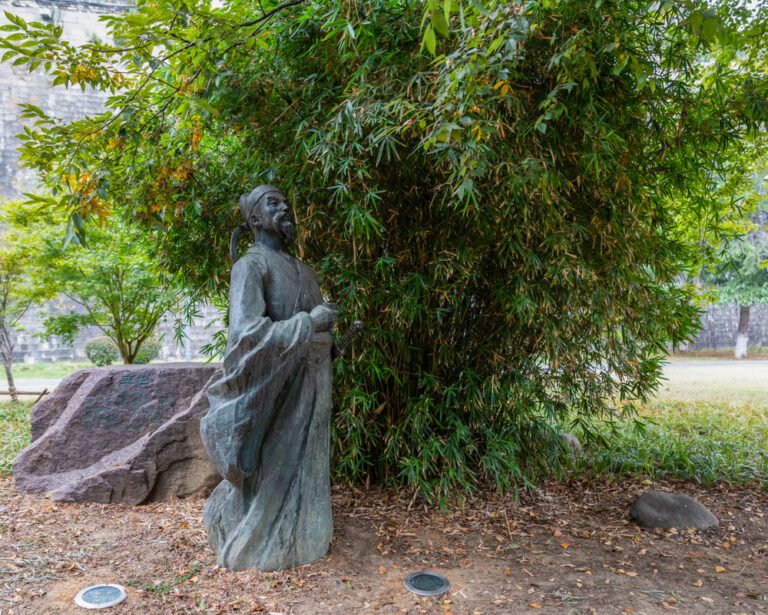Chinese for the Soul: Chinese Poetry and Language Learning

Welcome to a journey through time and language, where the ancient and modern worlds of Chinese poetry meet. Have you ever found yourself lost in the pages of a book, only to discover it was a portal to another culture, another way of thinking? That’s the magic of Chinese poetry, a treasure trove of linguistic richness and cultural wisdom.
From the intricate forms of ancient Chinese poetry to the vibrant expressions of modern Chinese poetry, each poem is a window into the soul of its era, offering a unique perspective on life, love, and the human condition.
For those learning Mandarin, diving into Chinese poetry isn’t just a scholarly pursuit; it’s a thrilling adventure. Whether you’re flipping through classic Chinese poetry books, exploring the various Chinese poetry forms, or delving into Chinese poetry in translation, you’ll find that each line, each Chinese character, holds a world of meaning.
It’s not just about the words; it’s about the rhythm, the imagery, the emotion. It’s about connecting with the poets who, centuries ago, poured their hearts into these verses, leaving behind a legacy that continues to inspire and enlighten. This is about experiencing the beauty of Mandarin in its most artistic form, about seeing the language through the lens of its most celebrated poets.
From the timeless works of ancient masters to the bold voices of contemporary writers, we’ll discover how Chinese poetry can enrich our understanding of Mandarin and connect us more deeply to the culture that gave birth to these incredible works.
So, grab your favorite anthology or open up a digital collection of Chinese poetry. Get ready to immerse yourself in the rhythm, the sounds, and the soul of Mandarin as we explore the fascinating world of Chinese poetry together.
Related Reading: How to Learn Chinese Characters in Seconds
The essence of Chinese poetry

Let’s jump straight into the mesmerizing world of Chinese poetry, where ancient whispers meet modern voices. This is more than a simple literary journey; it’s a time travel experience through the heart and soul of China, told through its poetry.
Ancient Chinese poetry: Where It all began
The ancient times is where our journey through Chinese poetry begins. Imagine sitting under a starlit sky, a scroll of delicate rice paper in hand, ink still fresh from the thoughts of a poet centuries ago. That’s the essence of ancient Chinese poetry — timeless, profound, and deeply connected to nature and human emotion. These poems aren’t mere words; they’re the heartbeats of a bygone era, echoing through time.
The beauty of these ancient poems lies in their content and forms. Think about it — each form, whether it’s a quatrain or a more elaborate structure, is like a unique dance of words, each step meticulously crafted to convey the deepest of emotions and the most profound of thoughts. And when you delve into these ancient poems, you’re not just reading, you’re connecting with the wisdom of the past.
The evolution into modern Chinese poetry
Fast forward to modern times, and you’ll see how Chinese poetry has evolved, mirroring the changing landscapes of society and culture. Modern Chinese poetry speaks in a different tone — it’s bolder, freer, and often more direct. But don’t be fooled. It’s as rich and nuanced as its ancient predecessors. This is where you witness a blend of traditional themes with contemporary issues, creating a tapestry of words that resonates with today’s world.
Modern poets have taken the liberty to experiment with forms, breaking free from the classical constraints to express their thoughts in new, exciting ways. It’s like watching a fusion dance of the old and new, each poet adding their unique twist to the legacy of Chinese poetry.
Diving into Chinese poetry forms
Whether ancient or modern, Chinese poetry forms are fascinating. Each form has its rules, its rhythm, its soul. You’ve got your classic forms, the Shi, Fu, and the Ci, each with unique flavor and style. Then there are the modern forms that have emerged, challenging the norms and inviting us to see the language from fresh perspectives.
Exploring these forms is like exploring different worlds within the universe of Chinese poetry — each world with its own landscape and its own music. And as you traverse these worlds, you begin to appreciate the versatility and richness of the Chinese language.
The treasure trove of Chinese poetry books and translations
Now, if you’re wondering where to start, there’s an endless number of Chinese poetry books out there. From anthologies of ancient poems to collections of modern masterpieces, these books are your gateways into the world of Chinese poetry. And the best part? Many come with translations, making them accessible to Mandarin learners.
Chinese poetry in translation opens doors for us to understand and appreciate the nuances of the language. It’s like having a bilingual guide on this poetic journey, helping you navigate the depths of meaning and beauty in each poem.
Related Reading: How Sacrificing Instant Gratification Helped Me Learn Chinese Faster
Why study Chinese poetry?

The study of Chinese poetry isn’t just about indulging in beautiful verses. It’s a strategic move that can enhance your Mandarin learning journey in multifaceted ways. Let’s explore why diving into the world of Chinese poetry can be a game-changer for language learners.
Memorability: The power of poetic recall
Poetry, with its rhythmic beat and often rhyming nature, has a unique way of embedding itself in our memory. This memorability aspect is crucial in language learning. When you engage with ancient Chinese poetry or its modern counterpart, you’re doing more than just reading — you’re participating in a form of passive memorization.
Lines from poems, with their poignant turns of phrase, are often easier to recall than standard textbook sentences. For example, a line from a classic Tang Dynasty poem might stick with you long after you’ve read it, subtly reinforcing language patterns and vocabulary.
Applicability: Translating analysis into understanding
Reading poetry requires a higher level of textual analysis, which is a valuable skill in language learning. As you dissect a poem, you grapple with its meaning, structure, and cultural context behind it. This analytical exercise enhances your ability to understand and use Mandarin, helping bridge the gap between theory and practical application. It’s about seeing the language in action and learning how to flexibly use it in various contexts.
Rhythmicality: Feeling the pulse of the language
Chinese, as a tonal language, possesses a natural rhythm that’s beautifully showcased in poetry. This rhythmic quality is essential for achieving fluency. By reading poetry, especially out loud, you get a feel for the cadence of the language. You start to understand how native speakers play with tones and syllables, which is invaluable for improving your Chinese pronunciation and spoken Mandarin.
Cultural connectivity: Bridging language and culture
Language and culture are deeply intertwined, and this is particularly evident in Chinese poetry. Engaging with poetry allows you to delve into the heart of Chinese culture. From ancient verses that reflect historical values to modern poems that comment on contemporary society, each piece gives you a deeper understanding of the cultural backdrop of the Mandarin language.
Digestibility: Small bites, big gains
Compared to novels or extensive textbooks, poems are often short and digestible. This makes them perfect for setting achievable language learning goals. You can take one poem at a time, dissect it, understand it, and appreciate it without feeling overwhelmed. It’s about quality over quantity, where even a small verse can offer a wealth of learning.
Confidence building: From recitation to conversation
Finally, the study of poetry builds confidence. Knowing a poem by heart, understanding its cultural significance, and being able to discuss it can give you a sense of accomplishment. This confidence often translates into other areas of language learning, encouraging you to take risks and use the language more freely in conversations.
Studying Chinese poetry is more than a linguistic exercise. It’s a holistic approach to understanding and appreciating Mandarin, connecting you deeply to the language’s rhythm, culture, and history.
Related Reading: Best Way to Learn Mandarin by Yourself: 15 Essential Tips
The role of poetry in the Chinese education system

Poetry in Chinese education is a big deal, and we’re not just talking about casual reading in a literature class. Chinese poetry, especially ancient forms, is a cornerstone of the education system, deeply embedded in the curriculum and cultural fabric.
Emphasis on poetry in education standards
According to the Chinese Curriculum Standards of Compulsory Education (2011-Ed), there’s a significant emphasis on memorizing poems and prose. Why? Because these aren’t just words on a page — they’re the keys to understanding Chinese culture, history, and language. For example, students might memorize a poem from the Tang Dynasty not only to appreciate its beauty but also to grasp the historical context and linguistic nuances that are central to Chinese identity.
This approach is more than basic rote memorization. It’s about immersing students in the rich world of Chinese literature from a young age, allowing them to absorb and internalize the rhythms, patterns, and themes that have shaped the language over centuries.
The power of memory in learning
Memorizing poetry is an intellectual exercise that stretches beyond language acquisition. It’s a way to develop cognitive abilities, improve memory retention, and build a deeper appreciation for the subtleties of Mandarin. Remembering a line from a classic poem or understanding its metaphorical nuances can be a gateway to more complex linguistic and analytical skills.
The poems chosen for study often range from ancient classics to modern masterpieces, showcasing the diversity of Chinese poetry forms. Through this, students gain exposure to different eras and styles, from the structured elegance of ancient verses to the free-flowing expressions of modern poetry.
Accessing poetry beyond the classroom
For those learning Mandarin outside of China, tapping into this educational approach can be incredibly beneficial. There are numerous Chinese poetry books and anthologies, both in original Mandarin and in translation, that can serve as valuable resources. Whether it’s a collection of poems from the Tang Dynasty or a modern poet’s anthology, these books offer a glimpse into the poetic heart of Chinese education.
By engaging with these texts, language learners can align their studies with the methods used in Chinese schools, gaining a deeper, more nuanced understanding of Mandarin and the culture it represents.
The role of poetry in the Chinese education system underscores its significance not just in language learning but in shaping intellectual and cultural perspectives. As we continue to explore Chinese poetry, let’s remember that these verses are much more than simple words – they’re a bridge connecting us to the rich legacy and ongoing evolution of the Chinese language and culture.
Related Reading: Why Consistency Matters Most in Learning Chinese
Memory Techniques for Classical Chinese Poetry

Learning Chinese poetry isn’t just about reading and appreciating – it’s also about memorization, a skill that can greatly enhance your language learning experience. Let’s explore some fantastic methods for memorizing poetry and see how you can adapt them to your Mandarin studies.
1. Situational induction: Connecting poems with contexts
Situational induction involves linking a poem with a specific context or situation, making it easier to recall. For instance, if you’re learning a poem that describes the tranquility of a lake, you might visualize yourself standing at a peaceful lake scene every time you recite the poem. This method brings the poem to life, making it more memorable. It’s like creating a mental movie where each verse paints a part of the scene. This ties directly into the Hanzi Movie Method, which works in much the same way.
2. Combination of poetry and painting: A visual approach
Combining poetry with visual arts, like painting, can be a powerful memory aid. This method is especially effective with ancient Chinese poetry, which often features vivid imagery. By associating a poem with a particular painting or image, you create a strong visual memory. For example, when learning a poem about spring, you might associate it with your favorite painting of blossoming flowers. This not only aids memorization but also enhances your appreciation of the poem’s aesthetic qualities.
3. Reproduction of poetic field: Immersing in the ambiance
This technique involves immersing yourself in the atmosphere or mood of the poem. If a poem is about a bustling marketplace, try to imagine the sounds, sights, and smells of such a place while reciting the poem. This method helps in internalizing the poem’s essence, making it easier to remember and understand.
4. Association of images: Linking words to pictures
Associating words or phrases in the poem with specific images can be an effective memory tool. For instance, if a poem mentions the Moon, you might visualize a bright full moon every time that word appears. This technique is particularly useful for learners who are more visually inclined.
Adapting techniques for modern learners
As a modern learner of Mandarin, you can adapt these techniques to suit your learning style. Try combining them with digital tools — use apps that allow you to visualize poems or create mind maps linking verses with images or situations. You could also illustrate the poems yourself or find artwork online that resonates with the themes of the poems you’re studying.
Remember, the key is to engage with the poetry on multiple levels — not just as text on a page, but as a living, breathing part of Chinese culture and language. By applying these memory techniques, you’ll find that the verses stick in your memory and enrich your understanding of Mandarin.
Incorporating these memory techniques can transform your experience of learning Chinese poetry from a mere academic exercise to a vivid, culturally immersive journey. As you continue to explore and memorize these beautiful verses, you’ll find yourself getting closer to the heart of Mandarin, one poem at a time.
Related Reading: The Open Secret of Immersion Learning for Languages
Deep dive into a Chinese poem
Let’s take a closer look at a piece of ancient Chinese poetry, exploring how it can enrich our language learning journey. For this purpose, we’ll examine a snippet from a famous Tang Dynasty poem by Li Bai, one of China’s most celebrated poets.

The poem is Drinking Alone under the Moon, celebrated for its vivid imagery and profound expression of solitude. Li Bai crafts a unique scene where he enjoys wine alone, inviting the moon and his shadow to join him, creating a trio. The poem reflects on the companionship of the moon and shadow, highlighting Li Bai’s introspective and imaginative character.
This piece is a beautiful example of ancient Chinese poetry’s ability to convey deep emotions and connect with nature in a few well-chosen words. For more details and the full text in English, Chinese, and Pinyin, you can visit here.
A glimpse into Li Bai’s masterpiece
Consider these lines by Li Bai (translated to English for ease of understanding):
Sitting alone in the moonlight, I think of my distant home.
This snippet, though brief, is packed with emotion and imagery. It encapsulates the themes of solitude and longing prevalent in many of Li Bai’s poems.
Language and structure analysis
In the original Mandarin, the poem’s structure follows a classic format, with balanced and rhythmic lines. The choice of words and their arrangement are crucial, as they adhere to the tonal patterns and aesthetic principles of ancient Chinese poetry. This particular piece showcases Li Bai’s skill in creating vivid imagery with minimal words, a common trait in Chinese poetry.
Cultural significance
Li Bai’s poetry often reflects the Daoist ideals of harmony with nature and the universe, a philosophy deeply ingrained in Chinese culture. This specific poem resonates with the universal theme of homesickness, making it relatable across time and culture.
Utilizing the poem in language learning
For Mandarin learners, this poem offers a wealth of learning opportunities. Here’s how you can use it:
- Vocabulary building: The poem contains words and phrases rich in meaning and connotation, useful for expanding your Mandarin vocabulary.
- Understanding Chinese culture: By analyzing the poem, you gain insights into Chinese history and philosophy, particularly the importance of nature and introspection in Chinese thought.
- Pronunciation practice: Reciting the poem helps you practice the tonal nature of Mandarin and rhythm and flow in speech.
- Appreciation of poetic techniques: The poem is an example of how ancient Chinese poets used structure and word choice to convey deep emotions, enhancing your understanding of Chinese poetic forms.
Looking deeper into Li Bai’s poetry isn’t just a mere linguistic exercise. It’s a deep dive into the heart of Chinese culture and history. By studying poems like this, you’re not only learning a language, you’re connecting with the soul of a civilization.
Unlock the Magic of Mandarin: Your Journey to Fluency Begins Now
As we finish our poetic adventure through the enchanting world of Chinese poetry, remember that this is just the beginning of a deeper, more fulfilling journey into Mandarin. Through ancient and modern verses, we’ve explored the rhythmic beauty and rich cultural heritage embedded in every line and every character of Chinese poetry. Now, it’s your turn to transform this inspiration into action!
Ready to elevate your Mandarin skills and start on a path to fluency? The FREE Mandarin Fluency Scorecard is your gateway to understanding where you stand in your language learning journey and how to leap forward. In less than a minute, you can get a personalized assessment of your current Chinese skills and discover a tailored guide to fluency. Find your unique strengths, pinpoint those tricky barriers, and receive a custom report with immediate steps to enhance your learning.
Whether you’re a beginner or brushing up on advanced skills, this scorecard is designed to give you clarity and direction. It’s more than just an assessment; it’s a roadmap to unlocking your full potential in Mandarin.
So, why wait? Embrace the opportunity to learn Mandarin faster and easier. Click below and take that first impactful step toward mastery:
Remember, this journey is free and quick and could be the turning point in your Mandarin learning experience. Dive in and let the world of Chinese poetry guide you to new linguistic heights.








